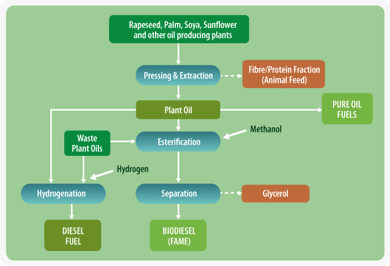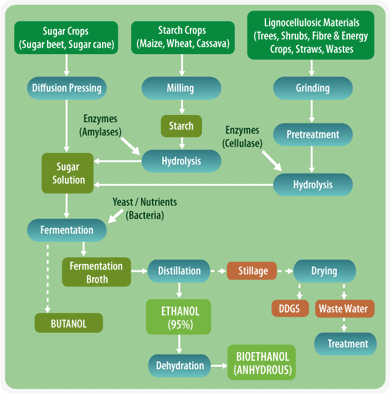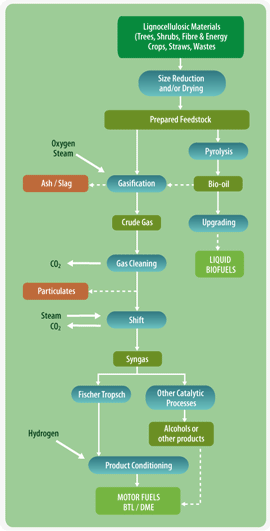Biofuel Production
Advanced biofuels
View figures on Advanced Biofuels planned production capacity US, EU and other countries 2009-2013 based on Biofuels Digest advanced production tracking database. All figures in Mgy. See also SuperData Free Access Global Biofuels Plant list
The term advanced biofuels may be used to describe:
a. Biofuels produced by advanced technology from non-food feedstocks (e.g. wastes, agricultural and forestry residues, energy crops). The end product (e.g. cellulosic ethanol or biodiesel) is the same as that produced by first generation technology. However, the 2G product is considered more sustainable as it generally offers greater levels of GHG reduction and/or does not use food crops as a feedstock.
b. The term "advanced biofuels" is also applied to biofuels with advanced properties, such as HVO, biopetroleum, bio jet fuel, biobutanol, etc.. These end-products may be more compatible with exisitng fuel infrastructures or offer other technical benefits. Biofuels with improved properties may be made from a range of feedstocks (including crops). Ultimately, the aim is to produce all such biofuels from sustainable feedstocks that are not considered to compete adversely with food production.
This is covered in detail in the sustainability section of the EBTP website.
Mapping of biofuels production and associated information
The BIOMAP is an initiative of DG ENER in an effort to facilitate the dissemination of results on biofuels of the European Commission's Framework Programmes (FP6 and FP7) as well as the Intelligent Energy Europe programme. A significant amount of data has been included covering industrial plants, biofuel quality standards, associations related to biofuels, EC policies, Member States policies, etc.
Introduction
The general information in this section is divided into two broad areas First Generation (biofuels from crops) and Second Generation (advanced sustainable biofuels, which are the focus of EBTP activities). This page includes a short overview of biofuel production and links to more detailed information on each technology, as well as diagrams and links to relevant research projects.
First Generation covers:
Biodiesel (RME)
Straight Vegetable Oils (SVO).
In general, first generation biofuels are produced from cereal crops (e.g. wheat, maize), oil crops (e.g. rape, palm oil) and sugar crops (e.g. sugar beet, sugar cane) using established technology. More detailed information is available on individual pages for each product.
The use of first generation technology has been the subject of considerable media attention, widespread public and political debate, and campaigns by civil societies to draw attention to the environmental and social impacts of biofuels from food crops. This is covered by the sustainability section of this website, which offers links and background information on Food v Fuel, Environmental Impact, Land Availability, Certification and Indirect Effects of bioenergy production.
The focus of the European Biofuels Technology Platform is on the demonstration of new technologies for industrial-scale production of Second Generation (2G) biofuels (advanced biofuels) from sustainable feedstocks. These include energy crops, algae, agricultural residues (e.g. straw, corn stover), waste streams (e.g. MSW, food waste), and forestry resources. The sustainability of advanced biofuels is also dependent on a net GHG reduction across each "value chain" (the specific combination of sustainable feedstock, conversion process and end products), with no "negative effect on biodiversity or land use".
Various "value chains" are being developed and demonstrated for the conversion of sustainable feedstocks into a range of biofuels, as well as other valuable by-products and/or heat and power.
Next Generation (advanced) biofuels include :
BioSynthetic Natural Gas (BioSNG)
Hydrocarbons from catalysis of plant sugars
Biofuels via synthetic biology and modified metabolism
In general, second generation biofuels are produced from cellulosic materials (lignocellulosic feedstocks). These raw material options may result in the production of more fuel per unit of agricultural land used and require less chemical and energy input per production and harvesting resulting in a higher yield in terms of net GJ energy produced per hectare land used. Such raw materials may be considered more sustainable and do not compete directly with food. However, there can be competition for land use as well as competition between the potential use of cellulosic materials for liquid biofuels and current (rapidly expanding) use for heat and power generation through combustion as solid biofuels.
New technology is being developed to produce biofuels from cellulosic materials. More detailed information is available on individual pages for each product.
Diagrams
>> EU supported R&D on Second Generation Biofuels
>> EU supported R&D on First Generation
Second Generation
EU Supported Research, Development and Demonstration activities and Related Studies
A full list of EC projects on biomass feedstocks, advanced biofuels, sustainability and market development is now included on the research funding page



